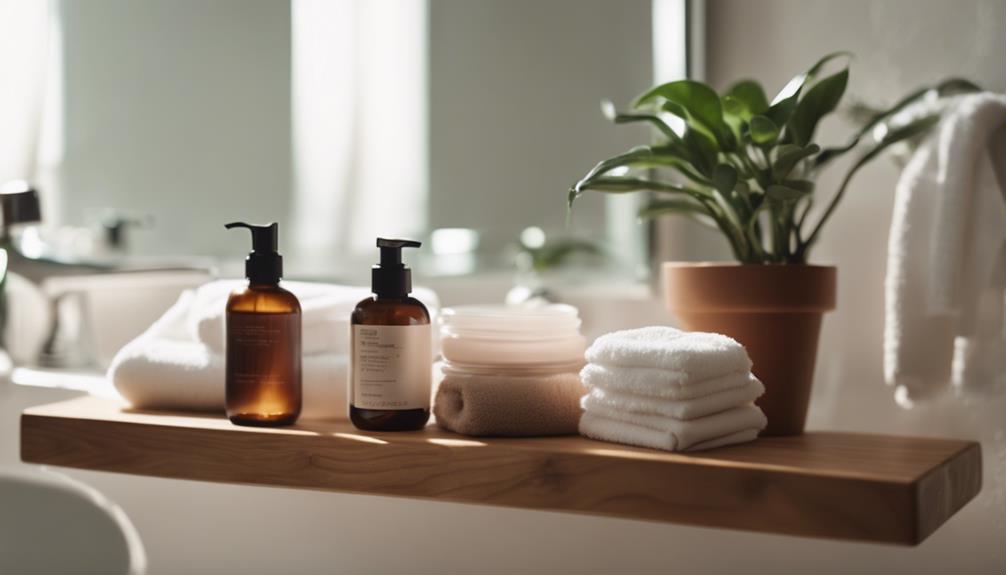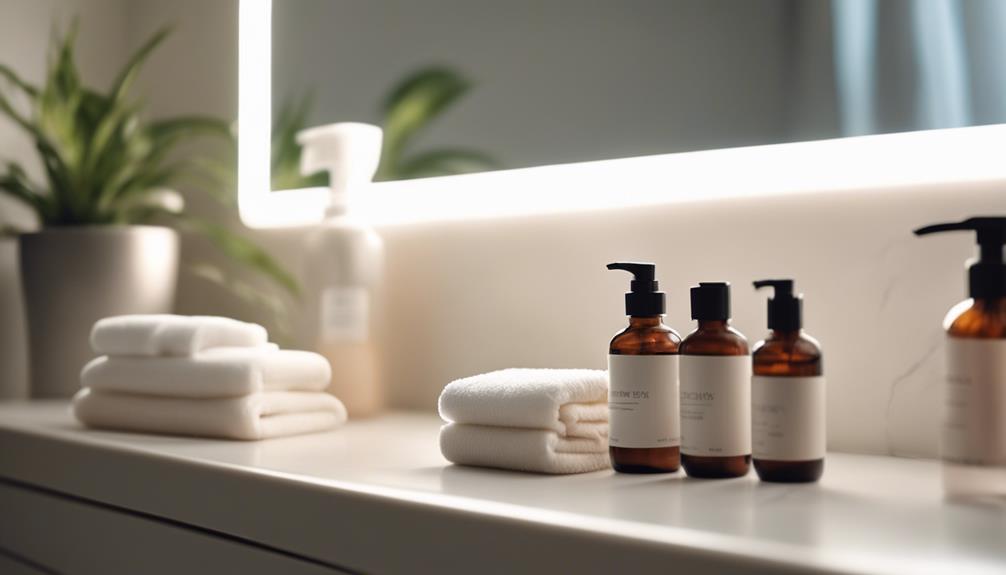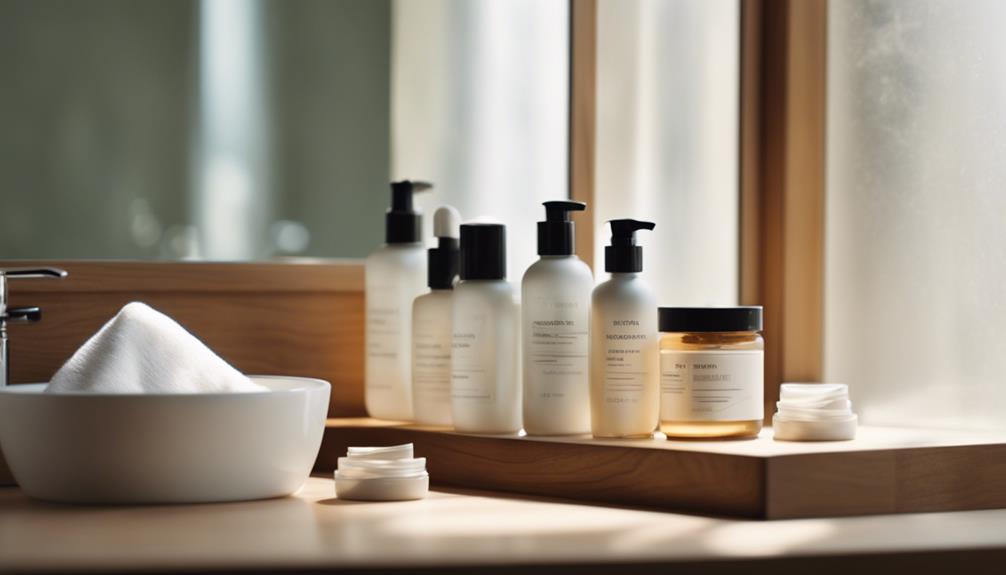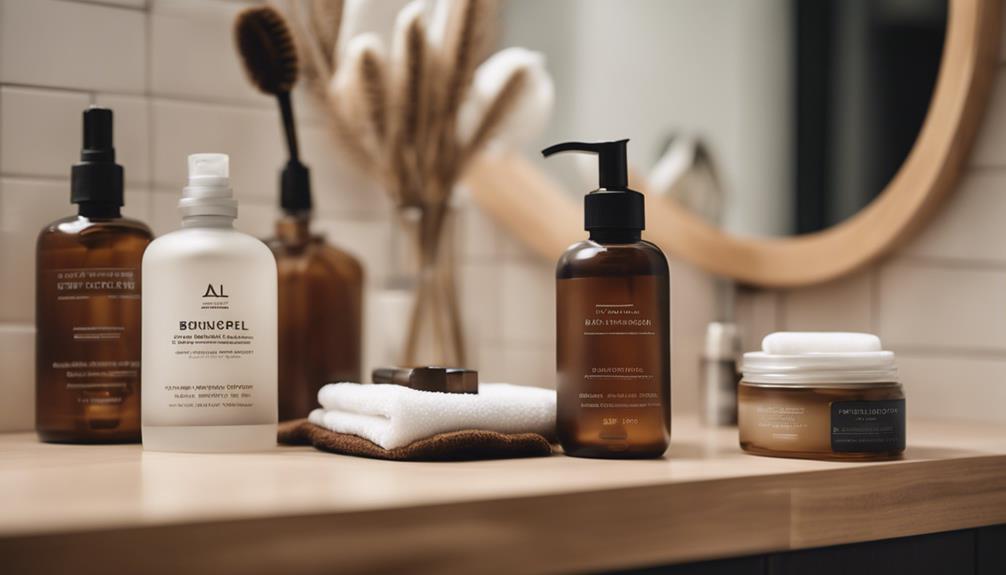To get started with a skincare regimen, the first step is to determine your skin type – be it oily, dry, combination, sensitive, or normal. Cleanse your skin twice daily using a mild cleanser, followed by moisturizing based on your skin’s specific needs. Don’t overlook the importance of sunscreen; it is crucial for safeguarding against UV damage. Incorporate exfoliation into your routine once or twice weekly to enhance the absorption of active ingredients like hyaluronic acid or vitamin C. Always remember to patch test new products to prevent any adverse reactions. Consistency is crucial, so establish a routine that suits you and adapt it as your skin evolves. There is a plethora of options to explore in order to perfect your skincare regimen!
Key Takeaways
- Identify your skin type (oily, dry, sensitive, combination, normal) to choose suitable products for your routine.
- Establish a basic routine: cleanse, moisturize, and apply sunscreen daily for optimal skin health.
- Use gentle cleansers and moisturizers that match your skin type to maintain balance and hydration.
- Incorporate broad-spectrum sunscreen with SPF 30 or higher to protect your skin from UV damage.
Identify Your Skin Type
Identifying your skin type is essential for choosing the right products that cater to your unique skincare needs. There are five primary skin types: oily, dry, sensitive, combination, and normal. Understanding your skin type helps you create an effective skincare routine.
If you have oily skin, you might notice a shiny appearance, larger pores, and a tendency to break out. On the other hand, dry skin can feel tight and rough, often showing signs of flakiness.
If your skin fluctuates between these two extremes, you likely have combination skin, where the T-zone is oily, but your cheeks feel dry.
Sensitive skin is another category. It's easily irritated, reacting negatively to certain fragrances or harsh ingredients. For this skin type, you'll need to choose gentle, fragrance-free skincare products to avoid flare-ups.
Essential Skincare Steps
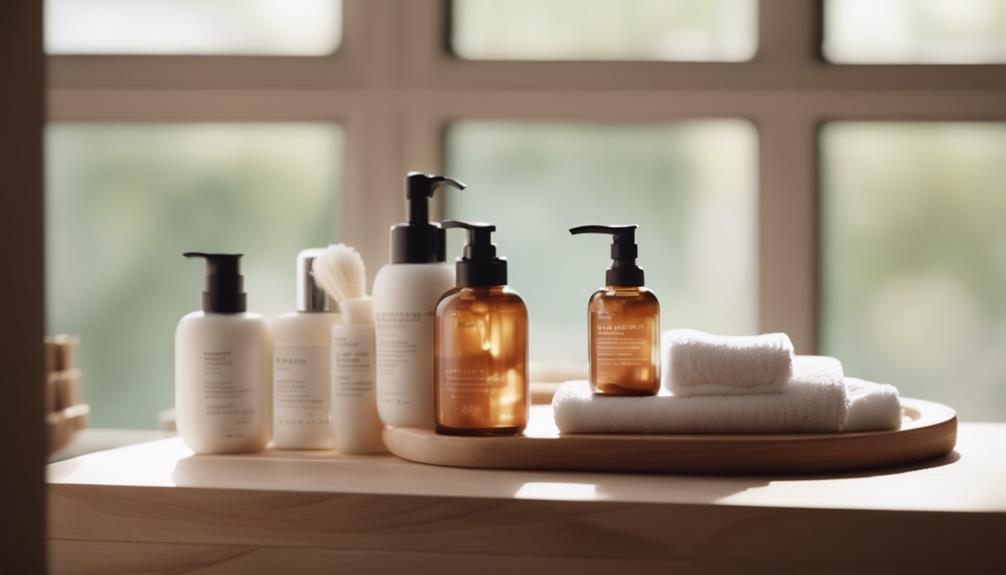
To achieve healthy skin, you can't skip the essential steps of cleansing and sunscreen application.
Cleansing your face twice daily removes dirt and impurities, setting the stage for better skincare.
Plus, applying sunscreen with at least SPF 30 daily is vital for protecting your skin from harmful UV rays.
Daily Cleansing Importance
Daily cleansing is essential for keeping your skin clear and healthy by removing dirt, oil, and impurities that can lead to breakouts. To achieve the best results, you should cleanse twice daily—once in the morning and once at night. In the morning, it helps to remove sweat and oil, while at night, it eliminates makeup and environmental debris.
Choosing a gentle hydrating cleanser that's suitable for your skin type is vital. This helps maintain your skin's natural moisture barrier and prevents irritation. When you cleanse, make sure to use proper cleansing techniques: massage the cleanser into your skin in circular motions for at least a minute, using lukewarm water to enhance effectiveness.
Regular daily cleansing not only promotes clearer skin but also prepares your skin for better absorption of subsequent skincare products like serums and moisturizers. By establishing this routine, you're taking a significant step toward healthier skin.
Sunscreen Application Necessity
Sunscreen application is essential for protecting your skin from harmful UV rays that can cause premature aging and increase the risk of skin cancer. Using a broad-spectrum sunscreen with an SPF of 30 or higher is vital for effective protection. You should apply it liberally to all exposed skin at least 15 minutes before heading outside.
Here's a quick guide to help you remember the key points about sunscreen application:
| Tip | Details |
|---|---|
| Choose the Right Sunscreen | Use broad-spectrum sunscreen with SPF 30 or higher. |
| Apply Liberally | Don't skimp! Make sure every exposed area is covered. |
| Timing | Apply sunscreen 15 minutes before sun exposure. |
| Reapply Frequency | Reapply every two hours, or more if sweating or swimming. |
You shouldn't skip this step, even if it's cloudy outside—up to 80% of UV rays can penetrate through clouds. Make sunscreen the last step in your morning skincare routine to shield your skin effectively from environmental damage.
Building a Basic Routine
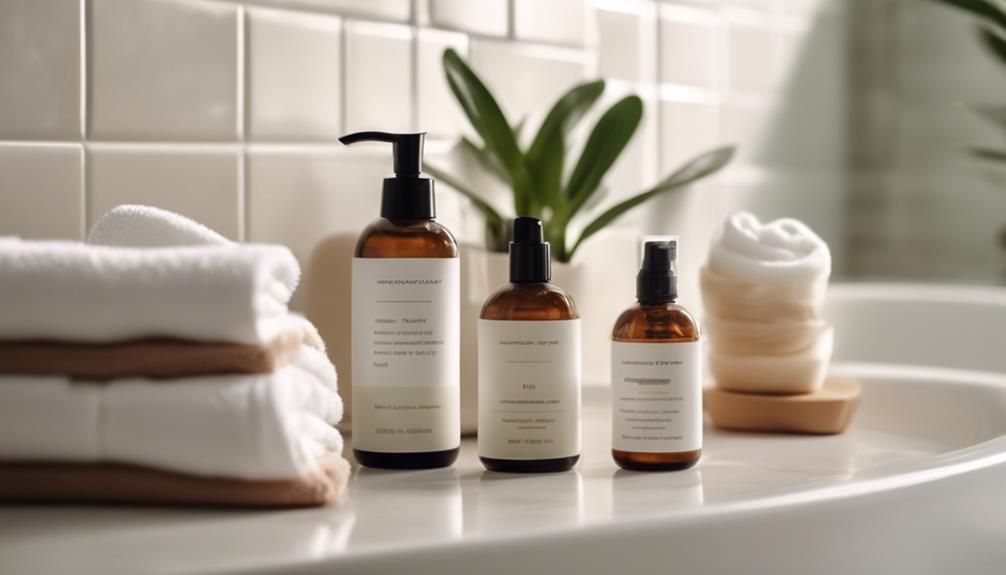
Establishing a basic skincare routine starts with three essential steps: cleansing, moisturizing, and applying sunscreen.
Begin your day by using a gentle cleanser tailored to your skin type. If you have dry skin, opt for a hydrating cream, while oily skin benefits from a foaming gel. Cleanse twice daily to guarantee your skin stays fresh and free from impurities.
After cleansing, it's time to moisturize. Choose a moisturizer that suits your skin type; lightweight gel formulations work best for oily skin, while richer creams are ideal for dry skin. This step locks in hydration, making your skin feel soft and supple.
Finally, don't skip sunscreen. Incorporate a broad-spectrum sunscreen with at least SPF 30 into your morning routine. This protects your skin from UV damage, which is vital for preventing premature aging and skin cancer.
As you grow comfortable with this basic routine, consider gradually adding products like serums or toners to address your skin's specific needs. Always monitor for any adverse reactions as you expand your regimen.
Choosing the Right Products
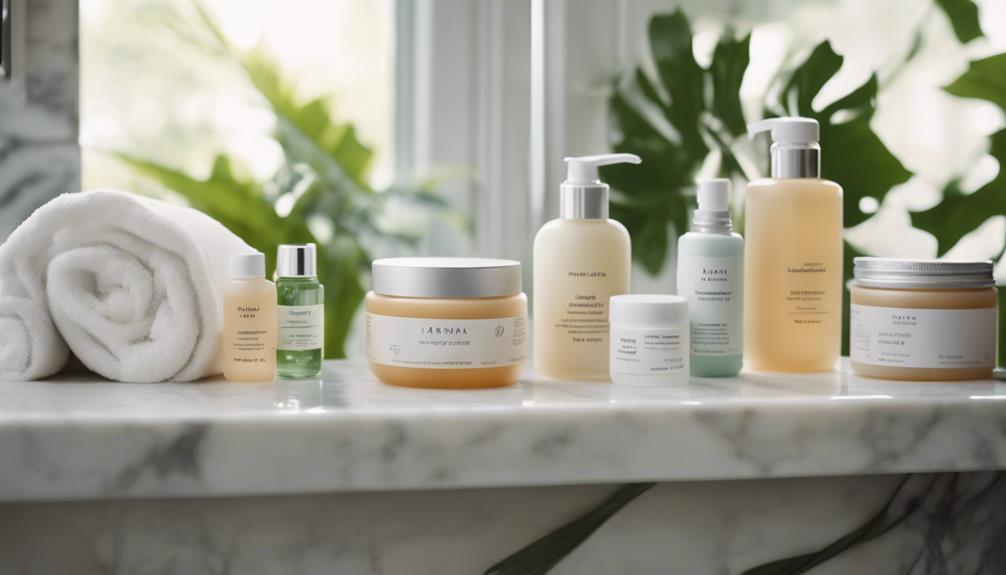
Choosing the right skincare products starts with identifying your skin type.
Once you know whether your skin is oily, dry, or sensitive, you can select essential ingredients that will work best for you.
Don't forget to patch test new products to ascertain they're compatible with your skin before fully incorporating them into your routine.
Identify Your Skin Type
Understanding your skin type is essential for selecting the right products that cater to your specific needs. Start by observing how your skin feels after cleansing. If your skin appears shiny and feels greasy, you likely have oily skin. Conversely, if your skin feels tight or flaky, it's probably dry skin.
For those with combination skin, you might notice both oily and dry areas, especially with an oily T-zone and dryness on your cheeks. If you experience redness or irritation, you may have sensitive skin, which requires gentle, fragrance-free formulations. Finally, normal skin maintains a balanced feel, without excessive oiliness or dryness, and usually just needs a standard moisturizing routine.
Once you identify your skin type, you can choose products accordingly. For oily skin, look for non-comedogenic options that won't clog your pores. If you have dry skin, rich moisturizers with ingredients like hyaluronic acid will help. For sensitive skin, opt for soothing, gentle ingredients.
Understanding your skin type is the first step in creating an effective skincare routine tailored to your unique needs.
Essential Ingredients to Consider
Selecting the right ingredients is essential for creating a skincare routine that effectively addresses your skin's unique needs.
If you have oily or acne-prone skin, prioritize non-comedogenic products to prevent clogged pores. Look for hydrating ingredients like hyaluronic acid and glycerin, which attract and retain moisture, making them suitable for all skin types.
Incorporate antioxidants, such as vitamin C, into your routine to protect your skin from environmental damage and promote a brighter complexion. If you have sensitive skin, opt for fragrance-free and hypoallergenic formulations to minimize the risk of irritation or allergic reactions.
It's also important to include active ingredients tailored to your specific concerns. For example, salicylic acid works wonders for acne, while retinol is a powerhouse for anti-aging.
By understanding your skin type and needs, you can select products that will help you achieve your skincare goals. Remember, the right combination of ingredients will enhance your skincare routine and lead to healthier, happier skin.
Always pay attention to how your skin reacts and adjust your product choices accordingly for the best results.
Patch Testing New Products
Before diving into a new skincare product, it's crucial to patch test it to guarantee your skin won't react negatively. Patch testing involves applying a small amount of the product on a discreet area, like behind your ear or on your inner arm. This method helps you check for any adverse reactions before you do a full application.
To effectively patch test, follow these steps:
| Step | Action | Wait Time |
|---|---|---|
| 1. Apply the product | Use a small amount on your skin area | 24-48 hours |
| 2. Observe | Look for irritation or redness | Check daily |
| 3. Evaluate | No reaction? | Safe to use |
| 4. Stay vigilant | Monitor skin condition post-application | Assess for changes |
Always patch test products, especially those with active ingredients like retinol or acids. These can often lead to skin irritation. Even if there's no reaction during the patch test, individual responses may vary, so keep an eye on your skin after you apply the product to your face. This extra step can save you from unpleasant surprises!
Exfoliation and Active Ingredients

Exfoliating your skin regularly can greatly enhance the effectiveness of active ingredients in your skincare routine. You can choose between physical exfoliants, like scrubs, or chemical exfoliants, such as AHAs and BHAs. While both methods have their benefits, chemical exfoliants generally promote better cell turnover and collagen formation, leading to smoother skin.
Aim to exfoliate once or twice a week to avoid over-exfoliation, which can irritate your skin and compromise its barrier. Once you've exfoliated, your skin is primed to absorb serums more effectively. These high-potency products deliver concentrated active ingredients, like vitamin C and hyaluronic acid, that target specific skin concerns.
For ideal results, layer your products correctly: apply lighter textures, like serums, before heavier formulations, such as moisturizers. This guarantees that the active ingredients penetrate deeply and work effectively.
Additionally, consider using face masks as a targeted treatment for specific issues, ideally once or twice weekly. Remember to apply them to clean, dry skin for the best results.
Common Skincare Mistakes
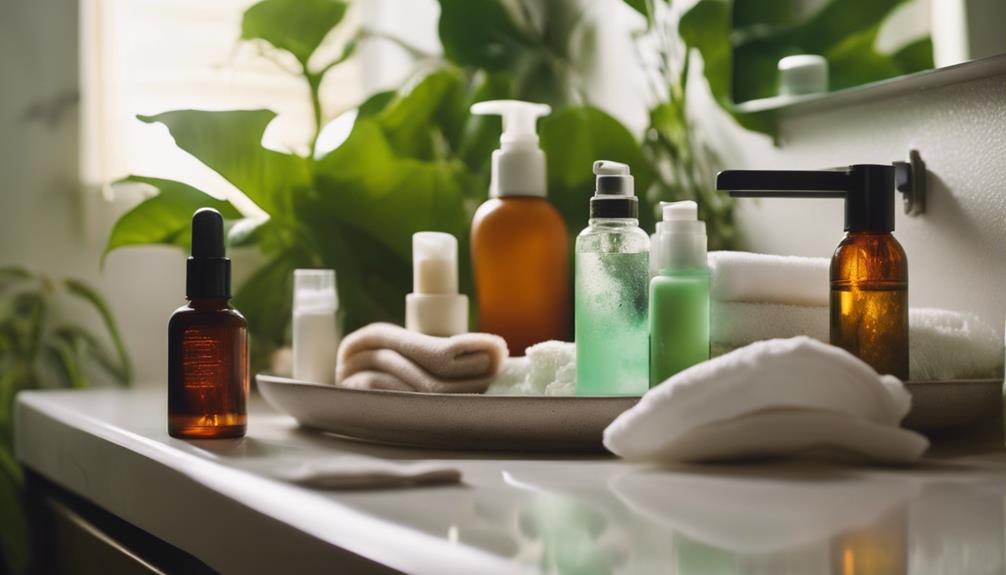
Even with a solid understanding of exfoliation and active ingredients, many people still make common skincare mistakes that can hinder their progress. Here are some pitfalls you should avoid to keep your skin healthy:
- Skipping sunscreen daily, even when it's cloudy, exposes your skin to harmful UV rays.
- Over-exfoliating too often can disrupt your skin barrier, leading to irritation and increased sensitivity.
- Neglecting to patch test new products might result in allergic reactions or breakouts; always test on a small area first.
- Using too many products at once can overwhelm your skin, making it tricky to pinpoint adverse reactions. Start with a few key products.
Expert Advice and Resources
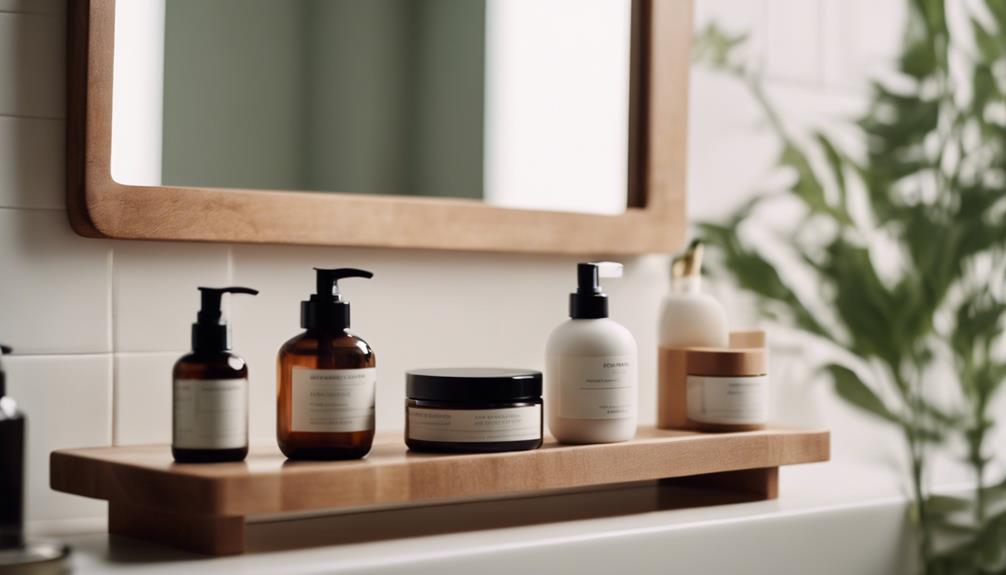
To effectively navigate your skincare journey, seek expert advice and utilize reliable resources that cater to your specific skin needs. Start by consulting dermatologists for personalized recommendations tailored to your skin type and concerns. This can greatly enhance the effectiveness of your skincare routine.
Utilize skin type quizzes and guides to better understand your unique skin needs and select appropriate products. It's vital to educate yourself on common skincare ingredients, like hyaluronic acid, which is known for its hydrating properties.
Stay updated on skincare trends and new ingredients by following reputable beauty editors and dermatologists on social media or subscribing to their newsletters. This will keep you informed about the latest advancements and best practices in skincare.
Additionally, engage with skincare communities online. Sharing your experiences and learning from others' successes and challenges can provide you with valuable insights and motivation.
Tips for Consistency and Patience
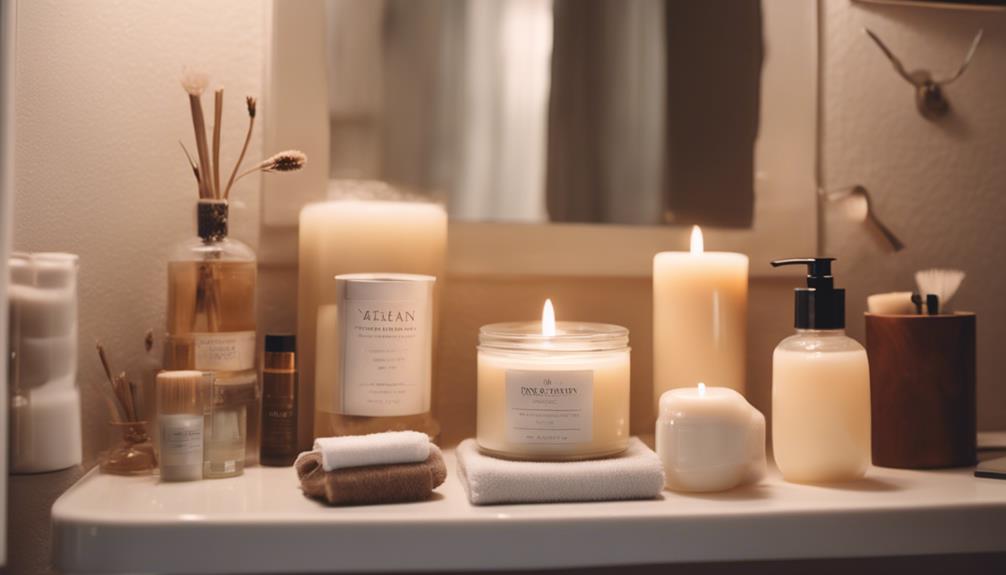
Sticking to your skincare routine daily is essential for seeing long-term results and maintaining healthy skin. Consistency is key; you'll likely start noticing improvements in skin texture around the six-week mark. So, practice patience.
Here are some tips to help you stay committed:
- Set a specific time each day to cleanse your skin, making it a non-negotiable part of your routine.
- Create a checklist to track your morning and nighttime rituals, ensuring no steps are skipped.
- Document your progress in a skincare journal, noting any changes or reactions to products that address your specific concerns.
- Stay flexible; adjust your routine as needed if you notice any issues or if your skin requires different care.
What Are Some Basic Beginner Tips for Starting a Skincare Routine?
When starting a skincare routine, personalized skincare routine tips can be helpful. First, determine your skin type to choose the right products. Then, cleanse, moisturize, and apply sunscreen daily. Don’t forget to exfoliate regularly and incorporate serums for specific concerns. Finally, be patient and consistent for best results.
Conclusion
Starting a skincare routine is like planting a garden—patience and care will yield beautiful results.
By understanding your skin type and following essential steps, you can nurture your complexion to bloom.
Remember, consistency is key; stick to your routine, and don't rush the process.
As you explore different products and techniques, be gentle with yourself and your skin.
With time, you'll see the fruits of your labor and feel more confident in your own skin.
